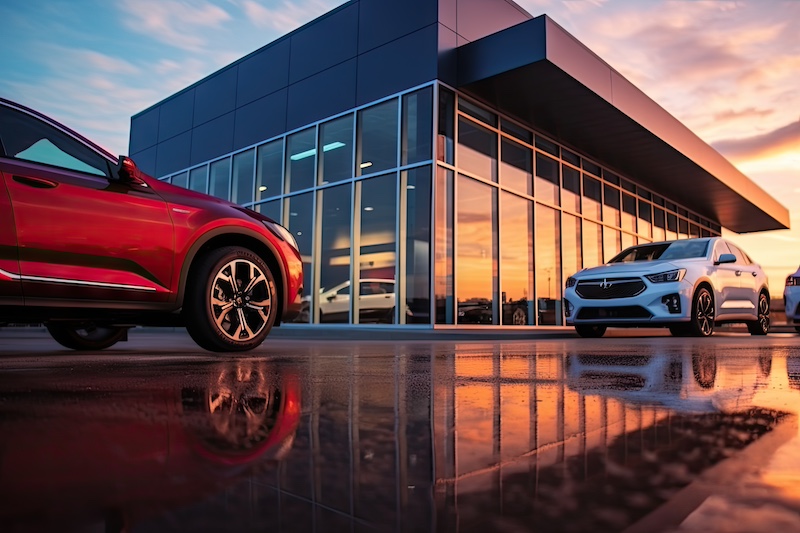I spend as much time outside of the car business today as I do in it and many of the online marketing professionals I interact with there have recently told me small is cool to customers. Small businesses, they say, have a personality, flavor and sensibility that big businesses can’t match, and when it comes to what you put on your web site, they urge: Don’t be afraid to tout your personality.
In the end I think that is what a lot of car dealerships web sites lack… “The Personality of the Business.”
“Small businesses can have more fun with their sites, more so than large corporations,” says Alice Bredin, president of Bredin Business Information, a Cambridge, Massachusetts, company that helps large business-to-business companies market themselves to small businesses. “A small-business site needs to include something that reflects the creativity and personality of its personnel.” After all people buy cars form people even if they do it online and over the phone it is still a personal connection between the prospect and the salesperson, service writer or manager involved.
“People want character; it has meaning,” adds Kelly Cutler, chief executive of Marcel Media, a Chicago-based Web advisory firm. “How folksy you get depends on your industry.” An attorney may not want to project an image of him or her working on a leather sofa with a dog curled up nearby. But that may work well for an artist or craftsperson, even an architect, Cutler and others say.
I say, get your people on your website, let prospective and current customers know who they are potentially going to deal with. Market them as hard as you market the car. The dealership down the road doesn’t have and can never have your people.
Whatever your industry, “Tell your story online,” Cutler says. Customers want to know who you are and, if you lead a team, who is on it and what they do. “You must talk about the team,” Bredin seconds. “When there is nothing [on your site] about who you are or who’s on your team, people wonder about whether you are a good company to buy from.”
But I am not just talking about an “about us” link in your navigation rather that a flash animation of vehicles, most of them the customer isn’t looking to buy why not put a great picture of the salesperson of the month up there and a story from a customer they helped. Why not put a picture of the service advisor that went above and beyond to help a customer with a service issue.
Your people are your value proposition
We spend so much time on the “market price” for new and used cars. We have allowed these market pricing tools to define us and that’s just not who we are and it isn’t right.
You are not a market price you are a service company with a product offering, so act like it. Market that personal service you give to your customers, they are willing to pay more for it. Don’t get sucked into the pundits that keep coming to your store and saying, “The reason your cars aren’t selling is your prices are over market”. The reason your cars aren’t selling is that you aren’t doing enough to get people to want to engage with you to buy a car from…period.
“People buy from people they like first and foremost” and they can’t like you from a listing or a price, they have to want to engage you.
Here are the 10 most important things we have found customers want to know:
1. How your dealership is unique
Answer the question “Who are you as a dealership?” as interestingly and compellingly (and honestly) as possible. This includes writing management bios that mention your expertise, years of experience and any unique attributes or details that may set you apart from others and marketing that not sticking it on a page deep in your website.
You need to answer “What is unique about your dealership? Why should I buy from you?” This is missing from many business sites because the owners haven’t done the strategic thinking necessary to figure that out.
Be concise, too, “You don’t need to write a novel.”
2. A clear sense of what your dealership offers beyond the cars you sell
“It’s incredible how many sites you visit and you’re not sure what the company offers,” Make it a priority on your home page to provide at least general information about your services not just the makes and models you sell, with links to specifics on a service pages. To visitors online sites just melt one into another you need to work to keep yours from melting into that pot.
Some also feel that consumers will have no reason to contact them by phone if they get all they need from the website. “There’s a balance that needs to be reached” in giving the potential customer enough info to make a buying decision. More often than not, consumers will not contact a company for the missing product information, they’ll just move on to a competitor. You must work to give the visitor all the information they need to make a buying decision on the vehicle then give them a compelling reason to contact you to finish the transaction.
3. Contact information, including a phone number and physical location
This may seem like a no-brainer, but I have seen too many web sites with no phone number or a really small phone number on the home page. You want the phone call; it’s 22 times more likely to sell than any other form of contact. So that should be the biggest thing visitors see everywhere.
Do yourself a favor ask your Internet department or site provider to give you the bounce rate from your Search Engine Response Page (SERP). This is the page that shows the listings for vehicles when a visitor searches. You’ll find you bounce rate is alarmingly high here (between 30% and 60%), this is also where your customers spend the most of their time. If you don’t have your phone number there then you’re killing yourself.
Secondly, if you want people to get to your dealership be sure your put that a link to your Google map in your listings as well not just in the Vehicle Display Page (VDP).
In the end make it easy for visitors to contact you anyway they want to and easy for them to find you when they want to come down to the store. Again I know this sounds like a no brainer but get on your web site right now and see if you can do that with in three or four clicks.
4. Third-party validation
This means customer testimonials, Facebook ratings, your eBay rating (if you have one), awards and recognition you’ve received, positive news and the like. Potential customers indeed want to know who you are in the community, and what current customers have to say about their experiences. Such items “forge the underpinnings of trust”.
Porter adds that having a presence on social networking sites and blogs, especially those serving your industry, is an increasingly popular form of validation among customers. “Social networking now has strong validation”. Social networking presence on your web site isn’t a Facebook or Twitter icon it a quote from your Facebook ratings, it’s your Twitter feed showing on your site. Putting these icons on your web site is a waste of space you haven’t done anything for me to want to friend you yet, so why would I click that?
5. Secure Socket Layer (SSL) and your privacy policy
SSL is an encryption system that helps protect the privacy of data exchanged between a customer and a website. If you are taking financial information customers want to know that their sensitive data is encrypted. You need to let them know in a really big way not just a little VeriSign image at the bottom of the app and get SSL if you don’t have it. If you do, let customers know that and about any other safeguards you proactively take.
Secondly, put a simple privacy policy under the submit button for your form submission it can be as simple as this, “We will never, ever sell or distribute your information with anyone…period.” Let them know this is for this transaction with your store only.
6. Ease of use and navigation
If people can’t find it, they can’t buy it. Keep your site “crisp, clean, and easy to navigate,” but also for site owners to study traffic and usage patterns to adjust their sites based on what visitors are coming for. “The ability to search a site is very important,” and “Dealers should study their search data to see if there are trends and what to make front and center.” Why not give the visitor a single keyword search field rather than a drop down four clicks just to get to the Ford F150’s on your site. Visitors are used to doing this in Google why would they not do it on your site?
7. Clear guidance on your processes
Let customers know, step-by-step, important things such as how to get an appointment, why that will save them time, why its important to call and what they get when they do that, where to go and what to do should something happen out of the ordinary. Last but not least, customers want to know how you handle complaints and problems and whether you have a money-back guarantee. If you have one, this is a huge thing. Get it out there and not just a small blurb on your site somewhere.
Your processes can be described in a FAQ (frequently asked questions) page or separate “how we work,” page that explains your unique selling proposition. Include a way customers can contact your dealership for more information.
8. An ability to give feedback
Encourage feedback about your products and services, your sales process and your site in general, by providing a feedback mechanism – either feedback forms or e-mail links. “You definitely want to look at how and what feedback to gather, and you should consider offering an incentive or perk [to the customer]” You might get some good stories to feature on your site or in your blog.
Consider just starting with a small survey, three questions on the home page of your site or when someone exits.
- What did you come here for?
- Did you find it?
- How could we have helped you better?
- Comment.
The more engagement you can get the more leads you will get not just from those that engage but more from those that see the conversations.
9. Clear calls to action:
Customers want signs or buttons in order to act, be it “buy now” or “sign up for our newsletter” or “click here for more information.” Go to your web site right now see if you can find those calls to action. You probably can’t. At some point in the technological evolution of the car business we forgot about asking for the business we just assumed the customer knew what to do. Don’t assume that, tell them what you want be specific, be clear and guide them to the conclusion of doing business with you. Visitors don’t want to think they just want information they are looking for to magically appear make that happen, then tell them that it happened and show them what to do next.
10. Special offers and personalization
By personalizing a sale with a special offer, incentive or coupon, dealerships can gain an edge on their bigger counterparts. This can be as simple as a handwritten thank-you note, free gift wrap services or a special offer for repeat business.
Having a thank you come up for return visitors to the web site with an oil change, pushing a personalized coupon to a visitor that has looked at a particular car more than once, giving a return service customer a certificate for preferential service treatment on their next visit. All of these things can and should be accomplished on your web site, you just have to decide this is the place for interaction.
In the end you need to really wrap your head around that the web is now the place where you do the “meet and greet” and that your site can set the tone for that next personal meeting. What tone are you setting right now?







